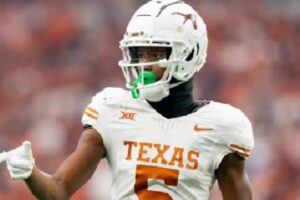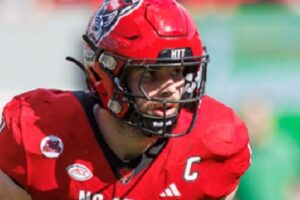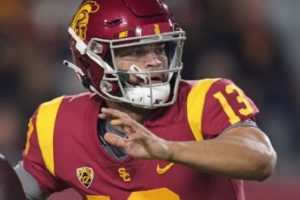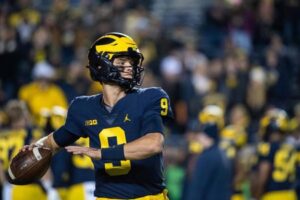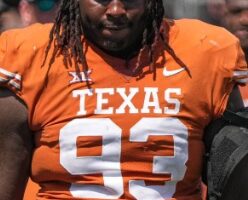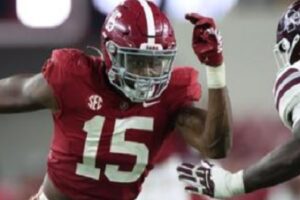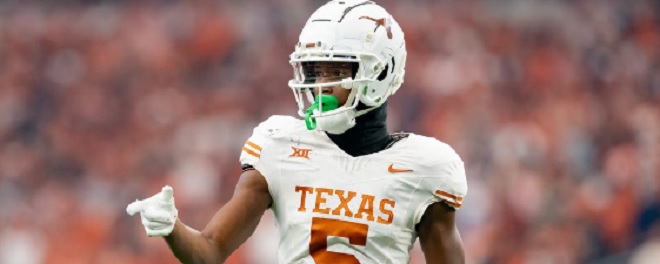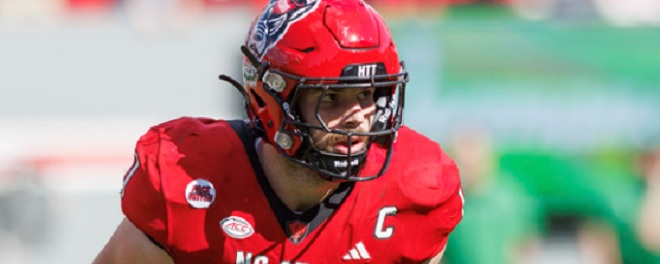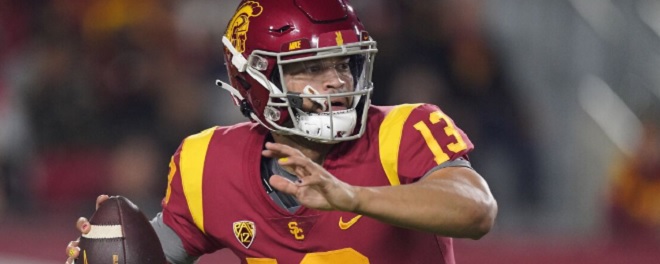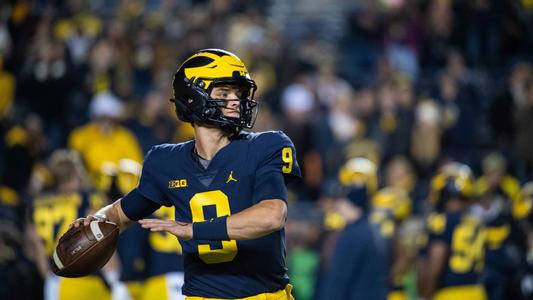By Charlie Campbell.
Send Charlie an e-mail here: [email protected]
Follow Charlie on Twitter @draftcampbell for updates.
This page was last updated March 6, 2014. Follow me @walterfootball for updates.
Position Review: Inside Linebackers
Inside Linebacker Class
Early-round talent: B+
Mid-round: C
Late-round: C
Overall grade: B
2014 prospects vs 2013
C.J. Mosley > Alec Ogletree
Chris Borland < Manti Te’o
Christian Jones < Kevin Minter
Carl Bradford < Kiko Alonso
Shayne Skov < Jonathan Bostic
Yawin Smallwood < Arthur Brown
Lamin Barrow < Sio Moore
Khairi Fortt > Zaviar Gooden
This is an interesting comparison. The 2014 NFL Draft class has more high-end talent, but the depth was drastically better a year ago. The 2013 NFL Draft’s class had eight inside linebackers drafted in the first three rounds. Even though the 2014 draft is more talented overall, this year’s inside linebackers may not produce eight players selected in the top 100. The 2014 class features an elite player at the top and a significant drop-off behind him.
Looking at the two classes together, Mosley would be the highest-rated prospect. However, in my opinion, Ogletree has more upside and I think he’ll turn into the better pro than Mosley. That being said, Kiko Alonso could end up being better than all of them.
If you were to merge the two classes as prospects, Mosley would go first. Borland, Jones, Bradford, Skov and Smallwood would all go behind Arthur Brown. That group is pretty equal to Sio Moore and they would all go ahead of Zaviar Gooden.
Safest Pick: C.J. Mosley, Alabama

There is no doubt that Mosley has a well-rounded game. He is excellent in pass coverage, and the NFL is a passing-driven league. Mosley is well suited to defend pro passing attacks. He also has some nice blitzing ability and instincts. His run defense got better throughout his time at Alabama. Mosley also is a smart player who made the checks and audibles for the Crimson Tide defense. It would be a shock if he didn’t turn into a solid pro linebacker.
Biggest Bust Potential: Chris Borland, Wisconsin

Borland is a favorite of a lot of the draft media, but I think he has some serious bust potential. I can explain it in three words: short and slow. If the NFL was the running-focused game of the 1980s and earlier eras, Borland would be tremendous. He’d be worth a first-round pick because he’s a great run-defender. But, the NFL is a passing-driven league now. Linebackers need to be able to match up against dangerous receiving tight ends and backs.
Borland (5-11, 248) is too slow to run with the fast tight ends, and he is very short, so even if he runs with tight ends, they can just make catches over him. I think Borland’s limitations in the passing game could turn him into a situational player in the NFL, and thus, he may not validate his draft slot. As a pass-defender, he is basically the opposite of Luke Kuechly in terms of length and speed. Ergo, I think Borland has some legitimate bust potential.
Inside Linebacker Rankings by Attributes
Pass Coverage:
NFL prototype: Luke Kuechly, Panthers
- C.J. Mosley
- Christian Jones
- Khairi Fortt
- Lamin Barrow
- Yawin Smallwood
- Shayne Skov
- Carl Bradford
- Chris Borland
Recap: The ability for a linebacker to be effective in pass coverage is mandatory in the passing-driven NFL. Defensive coordinators need linebackers who cover a lot of ground and can drop quickly downfield. Along with playing zone, linebackers who can effectively match up against the versatile pass-receiving tight ends and running backs out of the backfield are difficult to find.
Mosley is superb in pass coverage. He has the speed, agility and length to potentially match up with tight ends in man coverage. In zone, he covers a lot of ground and has good instincts. Mosley’s pass-coverage ability is one of his most intriguing attributes to NFL teams.
Jones (6-3, 240) is fast, agile and has length. He is well suited for the passing game and illustrated that more in the 2012 season. The versatile athlete should develop into a good pass-defender who has man coverage ability.
Fortt is an interesting defender in pass coverage. He does a nice job of covering ground and staying with receivers, but he could stand to improve his ball skills to prevent receptions when he has his man well covered. Fortt also operates well in zone coverage. He enters the league as a nice pass-defender with room to be even better.
Barron showed improved pass defense at the Senior Bowl. He did a nice job there of covering backs and tight ends. Smallwood and Skov have flashed nice pass-coverage ability, but are inconsistent. Skov has length, though he may be a little slow for NFL tight ends.
Bradford is a tough evaluation from a pass-coverage perspective because Arizona State used him as an edge rusher. He does have some speed and athleticism to work with.
As mentioned above, Borland’s pass coverage is very limited. He can function decently in zone coverage in the middle of the field, but that’s about it. Teams are going to target Borland with athletic tight ends, and I don’t think the results will be pretty for Borland’s team.
Run Defense:
NFL prototype: Patrick Willis, 49ers
- Chris Borland
- Shayne Skov
- C.J. Mosley
- Lamin Barrow
- Khairi Fortt
- Yawin Smallwood
- Christian Jones
- Carl Bradford
Recap: As multiple scouts told WalterFootball.com at the college all-star games, the thumper inside linebacker is a dying breed in the NFL. Still, teams have to have middle linebackers who can be tough run-defenders. They especially need pursuit skills with the rash of mobile quarterbacks and the success of the read option.
Borland is an awesome run-defender. He sheds blocks, tackles hard, reads his keys quickly and has a nose for the football. Even though Borland isn’t fast, he can still make some plays on perimeter runs. Borland is great against the run, and his best fit in the NFL may come on the inside of a 3-4 defense where he comes off the field in the nickel.
If you have doubts about Skov as a run-defender, just put on his games against Oregon. He is a tough player who can get off blocks and get to the ball-carrier. Skov’s senior year was much better as he was another year removed from his 2011 knee injury.
Mosley started out his career as a platoon player because Alabama had some bigger linebackers for the run, but by his junior season, Mosley was a main-stay and turned himself into a good run-defender. He gets to the perimeter well and also does a good job in the box.
Barrow, Fortt and Smallwood are also quality run-defenders. They have the quickness to go to the sideline and make tackles. All three could stand to get faster at processing plays and reading their keys.
Jones showed nice run defense as a junior at linebacker. As a senior, he played a lot of defensive end. Jones may need a little more time to get accustomed to playing inside linebacker, but he should turn into a quality run-defender in the NFL.
Bradford spent much of his time on the edge in college. He could stay at outside linebacker, but if he moves inside like some project, he’ll need some development to take on and shed blocks.
Read-and-React:
NFL prototype: Jerod Mayo, Patriots
- C.J. Mosley
- Chris Borland
- Shayne Skov
- Carl Bradford
- Yawin Smallwood
- Lamin Barrow
- Khairi Fortt
- Christian Jones
Recap: The ability to read his keys and instantly react to the play is a critical attribute for any inside linebacker in the NFL. The ones who do that well put themselves in position to make more tackles and produce more splash plays. This year’s group of linebackers does a solid job of this.
Mosley is the best read-and-react linebacker available. He not only used those skills to not only make a lot of tackles for Alabama, but he also put himself in position to make some impact plays in pass coverage.
Borland is superb with his read-and-reaction in the ground game. He sees what the offensive line is setting up and runs to the right spot. Borland will need to continue to improve on his read-and-react skills in pass coverage.
Bradford does a nice job of reacting to plays. He flows to the ball in run defense and gets upfield on pass plays. Smallwood and Barrow also react to plays quickly.
Fortt is a little slow at reading and reacting to some plays. At times he is quick, but other times, he can take some false steps or get caught by misdirection. Jones will need to get reacquainted with reading keys after the change in his role from last year.
Tackling:
NFL prototype: Vontaze Burfict, Bengals
- Chris Borland
- Lamin Barrow
- Khairi Fortt
- C.J. Mosley
- Shayne Skov
- Christian Jones
- Yawin Smallwood
- Carl Bradford
Recap: With each passing year, I think tackling is becoming a lost art in the NFL. Missed tackles are a plague on defenses that seems to get progressively worse every season. One of the primary reasons for this epidemic is the decreased training camp practices with less padded work and live hitting. Rule changes have also made tackling more difficult as players must avoid contact in certain locations and not use certain methods of taking down a ball-carrier. The end result is seeing a plethora of missed tackles on a down-by-down basis.
Borland is a fantastic tackler. He hits with authority while also doing a good job of wrapping up ball-carriers. When Borland got to the runner in 2013, they were going down. Borland could have some issues in the open field with faster and more athletic ball-carriers, but his tackling form looks NFL ready.
Barrow and Fortt are good tacklers. They’re strong and backs are generally unable to break out of his grasp, but both can have the tendency to go for some knockout blows when they instead need to wrap up.
Mosley is generally sound, but had some surprising missed tackles as a senior, especially in the Auburn game. At times, he was more of a drag-down tackler. Mosley is a good tackler, but he could use some development to be ready for the power backs of the NFL.
Skov is a reliable tackler. He flashes some plays where he stuffs ball-carriers and plants them in the ground. Jones was well coached at Florida State and mostly has good fundamentals in his tackling. Smallwood was consistent last season.
Bradford had some missed tackles at times and could use some work on his technique for the NFL.
Instincts:
NFL prototype: Patrick Willis, 49ers
- C.J. Mosley
- Chris Borland
- Shayne Skov
- Lamin Barrow
- Khairi Fortt
- Christian Jones
- Yawin Smallwood
- Carl Bradford
Recap: Instincts are what separate good linebackers from great ones. Having the innate feeling of what a offense is going to do is a huge factor for linebackers. It can help a player take the ball away, make a critical stop on a third down or consistently set up good down-and-distance situations for the defense. All great players are instinctive.
Considering Mosley’s well-rounded play against the run and pass leaves him as the most instinctive linebacker in this draft class – but that isn’t by a huge amount. Borland and Skov also possess good instincts. Those three players have all shown the ability to anticipate what is coming and get in position to make plays. Each should continue to have good instincts in the NFL after getting tuned in to the pro game. Mosley just has the edge in pass coverage, thus he’s rated first.
Barrow looked more instinctive at the Senior Bowl. He’s strong against the run and could improve in pass defense.
The bottom four linebackers here are pretty equal. They all flash good instincts, yet other times, seem to bite on misdirection. With some development in the NFL, their instincts could become a strength.
Pass Rush:
NFL prototype: Daryl Washington, Cardinals
- Carl Bradford
- Shayne Skov
- Christian Jones
- Chris Borland
- C.J. Mosley
- Khairi Fortt
- Yawin Smallwood
- Lamin Barrow
Recap: There aren’t too many inside linebackers in the NFL who consistently rush the passer, but 3-4 defenses especially like to have interior backers who can get after the quarterback.
Bradford is definitely the best pass-rusher in this group. He was an edge rusher for Arizona State and totaled 20 sacks over the past two seasons. Bradford also can move around and blitz from the inside. He is fast and agile to chase down the quarterback. For the NFL, Bradford’s blitzing ability is his biggest strength. He has nice pass-rushing potential and would be a good fit in a 3-4 defense.
Stanford used Skov in the pass rush, and he did well for the Cardinals with sack totals of 5.5 (2013) and 6.5 (2010). Skov times his blitzs well and closes in a hurry. Jones also spent a lot of time as an edge rusher. That was by need as Florida State lost Bjoern Werner, Tank Carradine and Brandon Jenkins to the 2013 NFL Draft. Still, Jones is fast and physical. He could be a weapon as a blitzer as a pro.
While Borland doesn’t project well in pass coverage, he is an excellent blitzer. Borland had four sacks in each of the past two seasons and does a good job of getting pressure when he charges after the quarterback. Borland could blitz on pass downs, but it could be an issue of predictability.
Mosley doesn’t get much credit for his pass rush because Alabama would always drop him into coverage, but when he did get to blitz, he affected the quarterback.
Fortt, Smallwood and Barrow weren’t really used as pass-rushers very much.
Shedding Blocks:
NFL prototype: Patrick Willis, 49ers
- C.J. Mosley
- Shayne Skov
- Lamin Barrow
- Chris Borland
- Carl Bradford
- Khairi Fortt
- Yawin Smallwood
- Christian Jones
Recap: Getting off blocks is a critical attribute for any linebacker in the NFL. Running around blockers results in busted gap integrity and can spring backs for big runs. Shedding blocks is one of the hardest aspects for a college player going to the the next level. A lot of the top linebackers in the NFL struggled with it early on.
Mosley could get more consistent, but as a senior, he was good about getting off blocks. Mosley has enough strength to do it in the NFL. Skov finished the year on a sour note in this regard against Michigan State, but he typically had the ability to shed blocks during his college career.
Borland does a pretty nice job of getting off blocks. However, his lack of length could hurt him in this regard in the NFL.
Bradford has some natural strength and athletic ability to defeat blocks in the NFL, but he will need coaching to develop the skill. Fortt and Smallwood both improved in this skill during their careers.
Jones is physical with offensive linemen, but after disengaging, he didn’t get to the ball-carrier often enough last season. Jones should get better after he has more time at his natural position.
Awareness:
NFL prototype: Luke Kuechly, Panthers
- C.J. Mosley
- Shayne Skov
- Chris Borland
- Lamin Barrow
- Khairi Fortt
- Yawin Smallwood
- Christian Jones
- Carl Bradford
Recap: Awareness is an increasingly important trait for linebackers given the read options and misdirection plays that are currently challenging defenses in the NFL.
Mosley has the best awareness of any linebacker in this draft class. He does a superb job of knowing what is going around in his surroundings. Mosley’s intelligence is one of his best traits.
Skove and Borland have very good awareness and typically do not get caught out of position. Barrow has awareness, but there were plays on which he bit on some fakes by the offense. Barrow should get better with more experience.
Fortt, Smallwood and Jones have room to improve their respective awarenesses. Bradford’s awareness was limited to rushing off the edge, defending runs straight at him or pursuing runs to the other side. He’ll need more grooming if he is to line up on the inside.
2024 NFL Mock Draft - April 23
NFL Power Rankings - Feb. 22
Fantasy Football Rankings - Feb. 19
NFL Picks - Feb. 12

